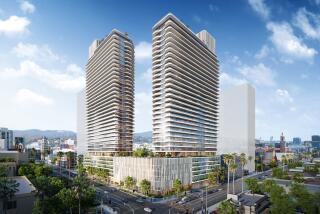ARCHITECTURE : Two Rodeo Drive--A Collage of What Beverly Hills Is All About
- Share via
Two Rodeo Drive is undoubtedly the most sophisticated mini-mall in the Los Angeles area. In fact, you might never even notice that it is just a fancy cousin of those parking courts fronted by yogurt shops and convenience stores. Two Rodeo Drive looks like a solid respectable sort of building, or rather like a row of buildings that are a natural part of the city, even if the stores include Tiffany’s and Dior.
From the outside, the only hint that this is not merely a continuation of that wonderful shopping village known as Beverly Hills is that there is a cobblestone street rising up steeply from the corner of Rodeo Drive and Brighton Way and moving through the heart of this seemingly solid structure. This road is no mere corridor or alleyway. It has sidewalks and street lights, but there are no cars allowed on it. The road is essentially the second floor of the shopping mall, masquerading as a real street.
Slowly it dawns on you how surreal Two Rodeo Drive is. The place is a collection of images drawn from European and American cities of the 19th and 20th centuries. It is pasted together to hide an ingenious, very modern split-level design that gives the developer double the number of ground-level stores while making Beverly Hills feel as though it avoids the mini-mall blight.
You are introduced to this collage of images when you drive down into what appears to be a standard parking garage, except that vaguely Classical columns define your path and preppy valets whisk your car away from a paved, planted turnaround.
You move through a vestibule of granite, ceramic tile and brick, are whisked up on a bronze elevator, and find yourself at the highest point of the mall, where there is an open tower reminiscent of a Midwestern bank building.
The street curves by an eclectic collection of facades, each a different variation on a kind of British classical scene. Pilasters, arched windows and heavy lintels are stamped out of concrete, covered with granite or outlined in wood. There is even a kind of Egyptian-style building, its ceramic tile columns topped with palm leaves.
To the south, past a scaled-down replica of the Tiffany’s store in New York, steps cascade alongside a fountain toward Wilshire Boulevard. There the building is transformed into a more muscular composition of angular forms whose colors and scale roughly mirror the somber, monumental presence of the Beverly-Wilshire Hotel across the street.
It is only when you enter the stores that you realize the cleverness of the scheme. The stores on Rodeo Drive all step down after the first 10 feet of storefront to allow the shops opening up from the interior mall to nestle over them. The likes of Valentino, Ferre and Porsche Design have outfitted their stores with expensive wood, stone and soft lighting, reflecting the expense of the site and the year in which we are living rather than the Disneyland-like exterior. The move from outside to inside is thus yet another sudden jump in this collage of images and forms.
Two Rodeo Drive is a summary of all of Beverly Hills, a collection of facades and borrowed elegance snaking its way over and past the support systems of cars, real estate deals and image-mongering that make it all possible--but always remain hidden.
More to Read
Sign up for Essential California
The most important California stories and recommendations in your inbox every morning.
You may occasionally receive promotional content from the Los Angeles Times.






